本节:写一个全栈博客网站。这一篇 主要是搭建了服务端的项目文件,写了接口,完成了路由中间件的调用,测试了接口可以使用,写了一个token;创建了数据库。
整个项目上传到了gitee,这是链接:VUE3 博客全栈: VUE3 博客全栈
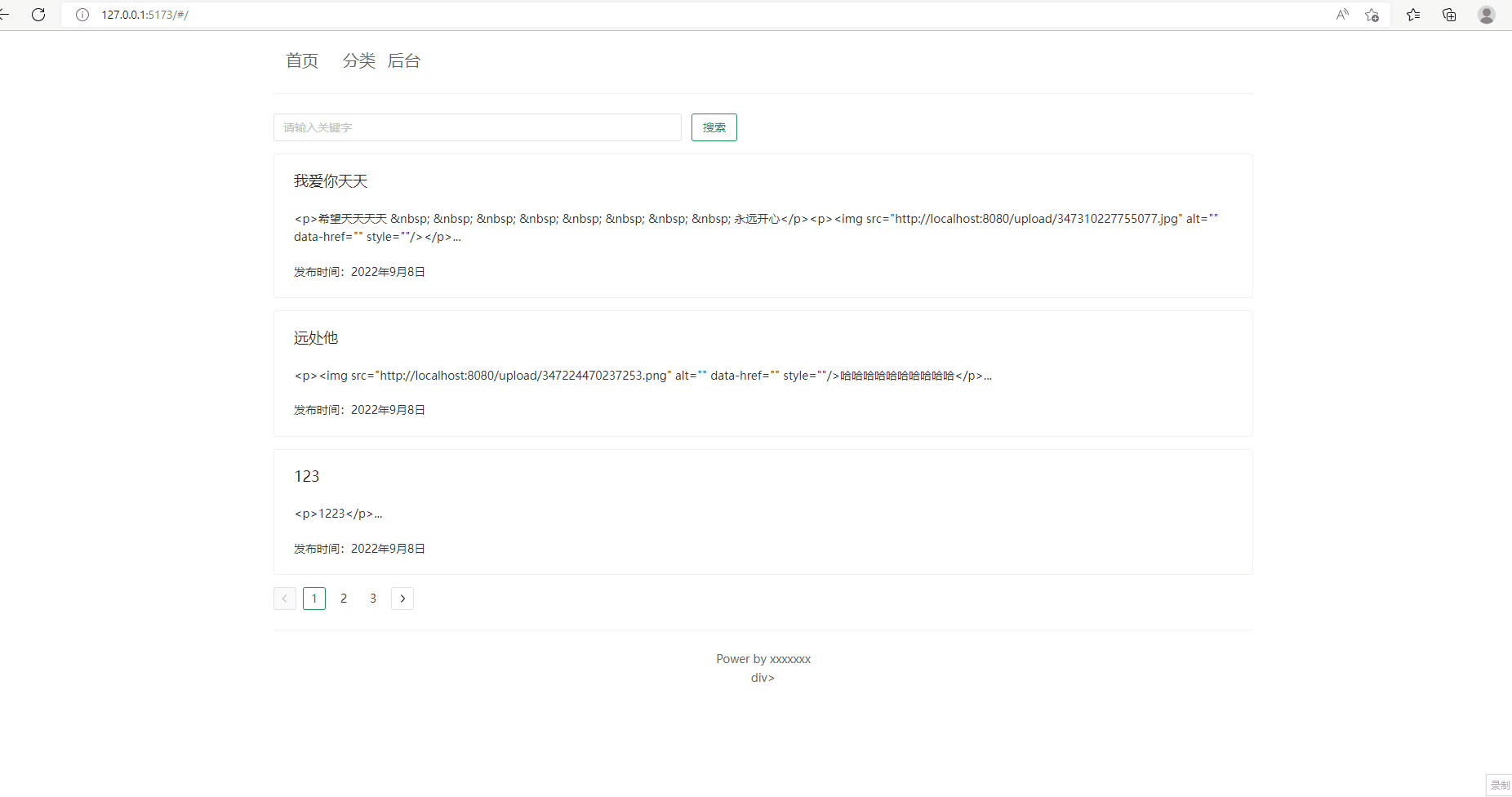
1.创建一个文件夹blog,路径下cmd,安装expres:
npm install express2.新建文件作为入口文件,文件名为app.js,还有文件上传的中间件:
(1)引入模块 (2)使用路由中间件 (3)端口监听 (4) 跨域设置
// 服务的的入口文件
// 需要安装几个模块:multer上传,sqlite3方便服务端的移植,uuid唯一标识 ,直接npm install 模块名
const express = require("express")//引入
const app = express();//实例化注册
const multer = require("multer")//引入上传
const port = 8080
//开放跨域请求,跨域请求放在在中间件的上面
app.use(function (req, res, next) {
//设置允许跨域的域名,*代表允许任意域名跨域
res.header("Access-Control-Allow-Origin", "*");
//允许的header类型
res.header("Access-Control-Allow-Headers", "*");
//跨域允许的请求方式
res.header("Access-Control-Allow-Methods", "DELETE,PUT,POST,GET,OPTIONS");
if (req.method == "OPTIONS") res.sendStatus(200); //让options尝试请求快速结束
else next();
});
app.use(express.json())//中间件
const update = multer({//上传的文件地址
dest :"./public/upload/temp"
})
app.use(update.any())//允许所有上传
app.get("/", (req, res) => {
res.send("hello world");
})
app.listen(port, () => {
console.log(`启动成啦: http://localhost:${port}/`);
// 这里注意是`` 这个,不是单引号
})3.在项目blog 终端,安装3个模块,multer上传,sqlite3方便服务端的移植,uuid唯一标识 ,直接npm install 模块名 ,就可以了
3.2 创建一个文件夹utils下面创建一个SnowFlake.js文件,创建后端自动生成的id。
/**
* @description:
* @author: bubao
* 生成雪花id,一万年都不重复
*/
class Genid {
/**
*Creates an instance of Genid.
* @author bubao
* @param {{
* Method: 1, // 雪花计算方法,(1-漂移算法|2-传统算法),默认 1
* BaseTime: 1577836800000, // 基础时间(ms 单位),不能超过当前系统时间
* WorkerId: Number, // 机器码,必须由外部设定,最大值 2^WorkerIdBitLength-1
* WorkerIdBitLength: 6, // 机器码位长,默认值 6,取值范围 [1, 15](要求:序列数位长+机器码位长不超过 22)
* SeqBitLength: 6, // 序列数位长,默认值 6,取值范围 [3, 21](要求:序列数位长+机器码位长不超过 22)
* MaxSeqNumber: 5, // 最大序列数(含),设置范围 [MinSeqNumber, 2^SeqBitLength-1],默认值 0,表示最大序列数取最大值(2^SeqBitLength-1])
* MinSeqNumber: 5, // 最小序列数(含),默认值 5,取值范围 [5, MaxSeqNumber],每毫秒的前 5 个序列数对应编号 0-4 是保留位,其中 1-4 是时间回拨相应预留位,0 是手工新值预留位
* TopOverCostCount: 2000// 最大漂移次数(含),默认 2000,推荐范围 500-10000(与计算能力有关)
* }} options
* @memberof Genid
*/
constructor(options) {
if (options.WorkerId === undefined) {
throw new Error("lost WorkerId");
}
// 1.BaseTime
const BaseTime = 1577836800000;
if (!options.BaseTime || options.BaseTime < 0) {
options.BaseTime = BaseTime;
}
// 2.WorkerIdBitLength
const WorkerIdBitLength = 6;
if (!options.WorkerIdBitLength || options.WorkerIdBitLength < 0) {
options.WorkerIdBitLength = WorkerIdBitLength;
}
// 4.SeqBitLength
const SeqBitLength = 6;
if (!options.SeqBitLength || options.SeqBitLength < 0) {
options.SeqBitLength = SeqBitLength;
}
// 5.MaxSeqNumber
const MaxSeqNumber = (1 << SeqBitLength) - 1;
if (options.MaxSeqNumber <= 0 || options.MaxSeqNumber === undefined) {
options.MaxSeqNumber = MaxSeqNumber;
}
// 6.MinSeqNumber
const MinSeqNumber = 5;
if (!options.MinSeqNumber || options.MinSeqNumber < 0) {
options.MinSeqNumber = MinSeqNumber;
}
// 7.Others
const topOverCostCount = 2000;
if (!options.TopOverCostCount || options.TopOverCostCount < 0) {
options.TopOverCostCount = topOverCostCount;
}
if (options.Method !== 2) {
options.Method = 1;
} else {
options.Method = 2;
}
this.Method = BigInt(options.Method);
this.BaseTime = BigInt(options.BaseTime);
this.WorkerId = BigInt(options.WorkerId);
this.WorkerIdBitLength = BigInt(options.WorkerIdBitLength);
this.SeqBitLength = BigInt(options.SeqBitLength);
this.MaxSeqNumber = BigInt(options.MaxSeqNumber);
this.MinSeqNumber = BigInt(options.MinSeqNumber);
this.TopOverCostCount = BigInt(options.TopOverCostCount);
const timestampShift = this.WorkerIdBitLength + this.SeqBitLength;
const currentSeqNumber = this.MinSeqNumber;
this._TimestampShift = timestampShift;
this._CurrentSeqNumber = currentSeqNumber;
this._LastTimeTick = 0;
this._TurnBackTimeTick = 0;
this._TurnBackIndex = 0;
this._IsOverCost = false;
this._OverCostCountInOneTerm = 0;
}
// DoGenIDAction .
DoGenIdAction(OverCostActionArg) { }
BeginOverCostAction(useTimeTick) { }
EndOverCostAction(useTimeTick) {
// if m1._TermIndex > 10000 {
// m1._TermIndex = 0
// }
}
BeginTurnBackAction(useTimeTick) { }
EndTurnBackAction(useTimeTick) { }
NextOverCostId() {
const currentTimeTick = this.GetCurrentTimeTick();
if (currentTimeTick > this._LastTimeTick) {
// this.EndOverCostAction(currentTimeTick)
this._LastTimeTick = currentTimeTick;
this._CurrentSeqNumber = this.MinSeqNumber;
this._IsOverCost = false;
this._OverCostCountInOneTerm = 0;
// this._GenCountInOneTerm = 0
return this.CalcId(this._LastTimeTick);
}
if (this._OverCostCountInOneTerm >= this.TopOverCostCount) {
// this.EndOverCostAction(currentTimeTick)
this._LastTimeTick = this.GetNextTimeTick();
this._CurrentSeqNumber = this.MinSeqNumber;
this._IsOverCost = false;
this._OverCostCountInOneTerm = 0;
// this._GenCountInOneTerm = 0
return this.CalcId(this._LastTimeTick);
}
if (this._CurrentSeqNumber > this.MaxSeqNumber) {
this._LastTimeTick++;
this._CurrentSeqNumber = this.MinSeqNumber;
this._IsOverCost = true;
this._OverCostCountInOneTerm++;
// this._GenCountInOneTerm++
return this.CalcId(this._LastTimeTick);
}
// this._GenCountInOneTerm++
return this.CalcId(this._LastTimeTick);
}
NextNormalId() {
const currentTimeTick = this.GetCurrentTimeTick();
if (currentTimeTick < this._LastTimeTick) {
if (this._TurnBackTimeTick < 1) {
this._TurnBackTimeTick = this._LastTimeTick - 1;
this._TurnBackIndex++;
// 每毫秒序列数的前 5 位是预留位,0 用于手工新值,1-4 是时间回拨次序
// 支持 4 次回拨次序(避免回拨重叠导致 ID 重复),可无限次回拨(次序循环使用)。
if (this._TurnBackIndex > 4) {
this._TurnBackIndex = 1;
}
this.BeginTurnBackAction(this._TurnBackTimeTick);
}
return this.CalcTurnBackId(this._TurnBackTimeTick);
}
// 时间追平时,_TurnBackTimeTick 清零
if (this._TurnBackTimeTick > 0) {
this.EndTurnBackAction(this._TurnBackTimeTick);
this._TurnBackTimeTick = 0;
}
if (currentTimeTick > this._LastTimeTick) {
this._LastTimeTick = currentTimeTick;
this._CurrentSeqNumber = this.MinSeqNumber;
return this.CalcId(this._LastTimeTick);
}
if (this._CurrentSeqNumber > this.MaxSeqNumber) {
this.BeginOverCostAction(currentTimeTick);
// this._TermIndex++
this._LastTimeTick++;
this._CurrentSeqNumber = this.MinSeqNumber;
this._IsOverCost = true;
this._OverCostCountInOneTerm = 1;
// this._GenCountInOneTerm = 1
return this.CalcId(this._LastTimeTick);
}
return this.CalcId(this._LastTimeTick);
}
CalcId(useTimeTick) {
const result = BigInt(useTimeTick << this._TimestampShift) + BigInt(this.WorkerId << this.SeqBitLength) + BigInt(this._CurrentSeqNumber);
this._CurrentSeqNumber++;
return result;
}
CalcTurnBackId(useTimeTick) {
const result = BigInt(useTimeTick << this._TimestampShift) + BigInt(this.WorkerId << this.SeqBitLength) + BigInt(this._TurnBackIndex);
this._TurnBackTimeTick--;
return result;
}
GetCurrentTimeTick() {
const millis = BigInt((new Date()).valueOf());
return millis - this.BaseTime;
}
GetNextTimeTick() {
let tempTimeTicker = this.GetCurrentTimeTick();
while (tempTimeTicker <= this._LastTimeTick) {
tempTimeTicker = this.GetCurrentTimeTick();
}
return tempTimeTicker;
}
NextId() {
if (this._IsOverCost) {
return parseInt(this.NextOverCostId());
} else {
return parseInt(this.NextNormalId());
}
}
}
module.exports = Genid;4.终端输入:就可以运行,看看 hello world 有没有在浏览器渲染出来,在浏览器渲染出来就说明文件可以了。
node app.js暂时的布局如下:
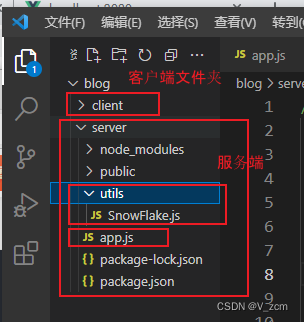
5.在server文件夹创建db文件,然后在数据库创建几个表,用户表,文章表,文章分类表。
数据库选择这种网络类型:
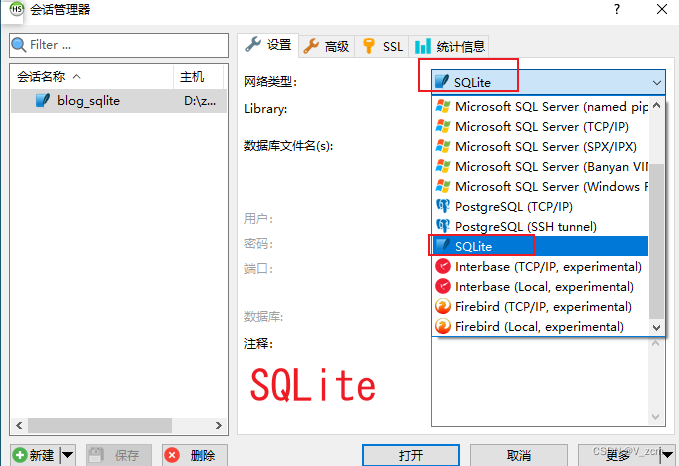
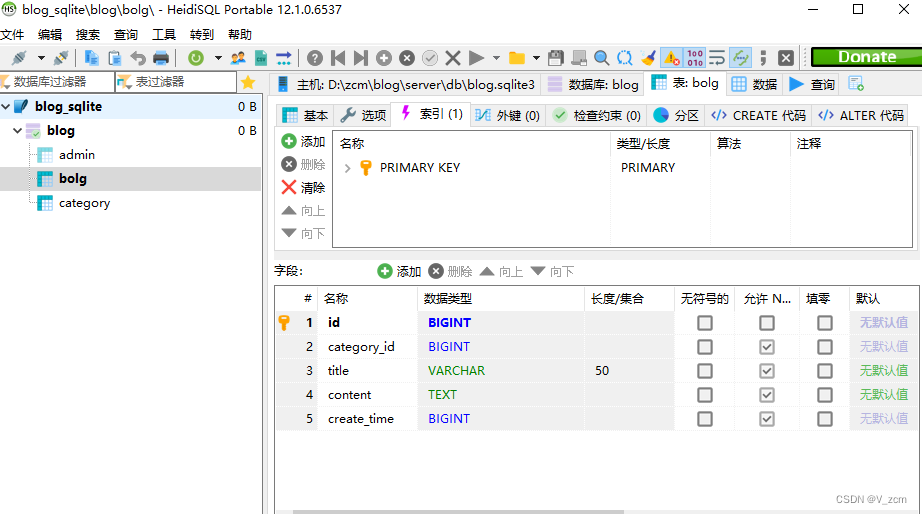
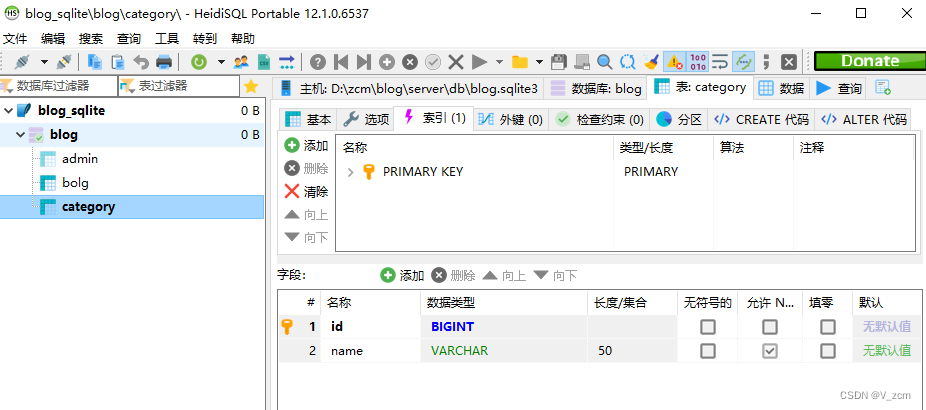
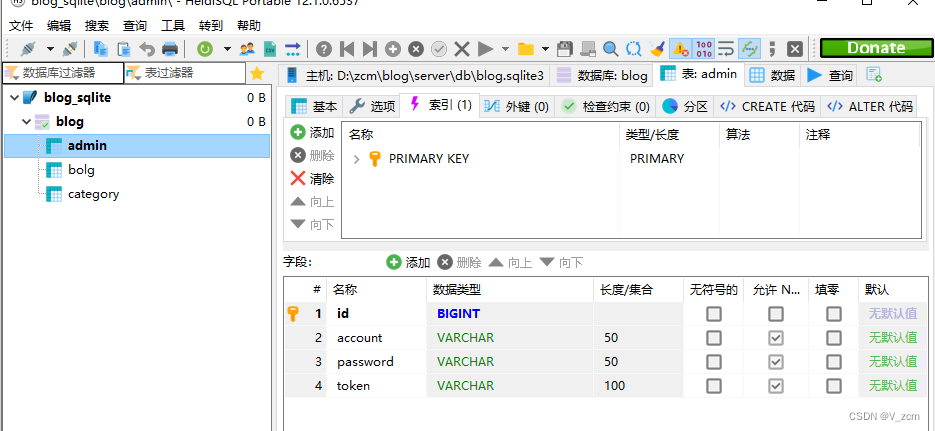
6.创建路由,连接数据库,查数据库的内容,看看有没有连接成功。在app.js引入路由。
(1)在db文件夹下面,创建DbUtils.js文件连接数据库,导出数据库,让别的地方可以用
const sqlite3 = require("sqlite3").verbose() //引入sqlite3
const path = require( "path")//获取地址,引入数据库
const Genid = require("../utils/SnowFlake")//引入雪花id
// db是暴露出去,给用户作为工具使用的
var db = new sqlite3.Database(path.join(__dirname, "blog.sqlite3"))//地址转换成字符串
//WorkerId是一个机器码,这样服务器的id就不会重复
const genid = new Genid({ WorkerId: 1 })//现在只有一个所以id先设置为1
module.exports = { db,genid} //把数据库和雪花id先导出去,就不会别的页面总是要引入了(2)创建router文件夹,创建TestRouter.js文件
const express = require("express") //1.引入express
const router = express.Router() //2.引入路由
const {db,genid} = require("../db/DbUtils")//引入雪花id和数据库
// // 4.测试接口
router.get("/test", (req, res) => {
db.all("select * from `admin`", [], (err, rows) => {
console.log(rows)
})
res.send({
id:genid.NextId(),
})
})
// 这里from打错了,导致查出来的内容是undifine
module.exports = router //3.导出路由
ps:这里from打错了,导致查出来的内容是undifine
(3)在app.js入口文件引入路由:
app.use("/test", require("./routers/TestRouter"))//引入路由
7.直接写sql语句,容易形成回调地狱,所以要用promise封装请求。
进行sql,和parms还有回调函数的一个封装, Promise的构造函数接收回调函数作为参数,resolve()异步回调将promise变为fulfilled(已成功)状态, reject()异步回调将promise变为rejected(已失败)状态,异步的写法,防止回调地狱。reject里面还有then方法可以对数据进行处理
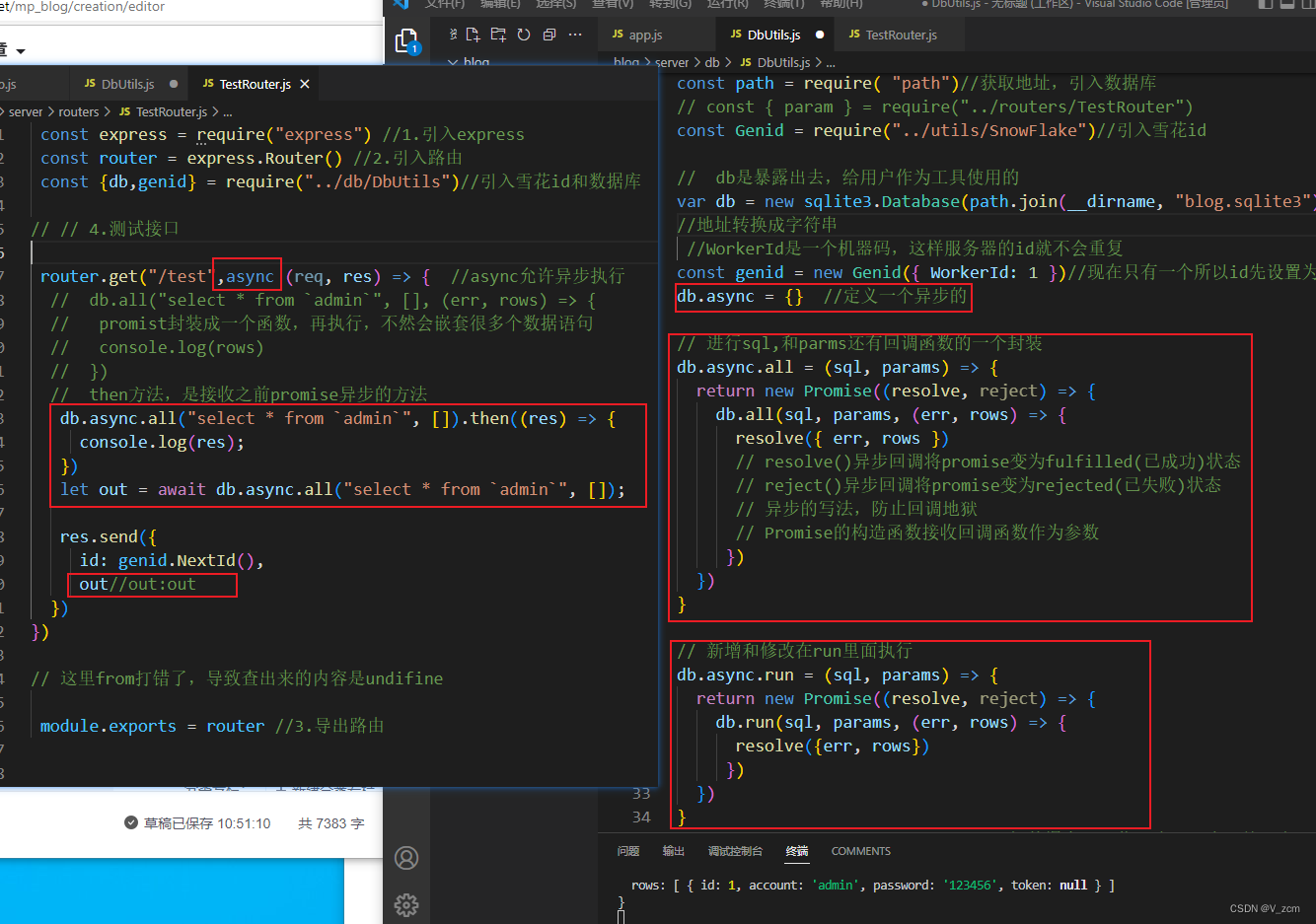
DbUtils文件:引入数据,做一个promise封装请求,防止回调地狱
const sqlite3 = require("sqlite3").verbose() //引入sqlite3
const { resolve } = require("path")
const path = require( "path")//获取地址,引入数据库
// const { param } = require("../routers/TestRouter")
const Genid = require("../utils/SnowFlake")//引入雪花id
// db是暴露出去,给用户作为工具使用的
var db = new sqlite3.Database(path.join(__dirname, "blog.sqlite3"))
//地址转换成字符串
//WorkerId是一个机器码,这样服务器的id就不会重复
const genid = new Genid({ WorkerId: 1 })//现在只有一个所以id先设置为1
db.async = {} //定义一个异步的
// 进行sql,和parms还有回调函数的一个封装
db.async.all = (sql, params) => {
return new Promise((resolve, reject) => {
db.all(sql, params, (err, rows) => {
resolve({ err, rows })
// resolve()异步回调将promise变为fulfilled(已成功)状态
// reject()异步回调将promise变为rejected(已失败)状态
// 异步的写法,防止回调地狱
// Promise的构造函数接收回调函数作为参数
})
})
}
// 新增和修改在run里面执行
db.async.run = (sql, params) => {
return new Promise((resolve, reject) => {
db.run(sql, params, (err, rows) => {
resolve({err, rows})
})
})
}
module.exports = { db, genid } //把数据库和雪花id先导出去,就不会别的页面总是要引入了TestRouter:写的一个路由中间件,是一个路由中间件的模板
const express = require("express") //1.引入express
const router = express.Router() //2.引入路由
const {db,genid} = require("../db/DbUtils")//引入雪花id和数据库
// // 4.测试接口
router.get("/test",async (req, res) => { //async允许异步执行
// db.all("select * from `admin`", [], (err, rows) => {
// promist封装成一个函数,再执行,不然会嵌套很多个数据语句
// console.log(rows)
// })
// then方法,是接收之前promise异步的方法
db.async.all("select * from `admin`", []).then((res) => {
console.log(res);
})
let out = await db.async.all("select * from `admin`", []);
res.send({
id: genid.NextId(),
out//out返回数据等于err,rows
})
})
// 这里from打错了,导致查出来的内容是undifine
module.exports = router //3.导出路由
7.写一个登录接口,如果登录成功,前端就把token传给后端。
(这个接口测试工具是 apifox)
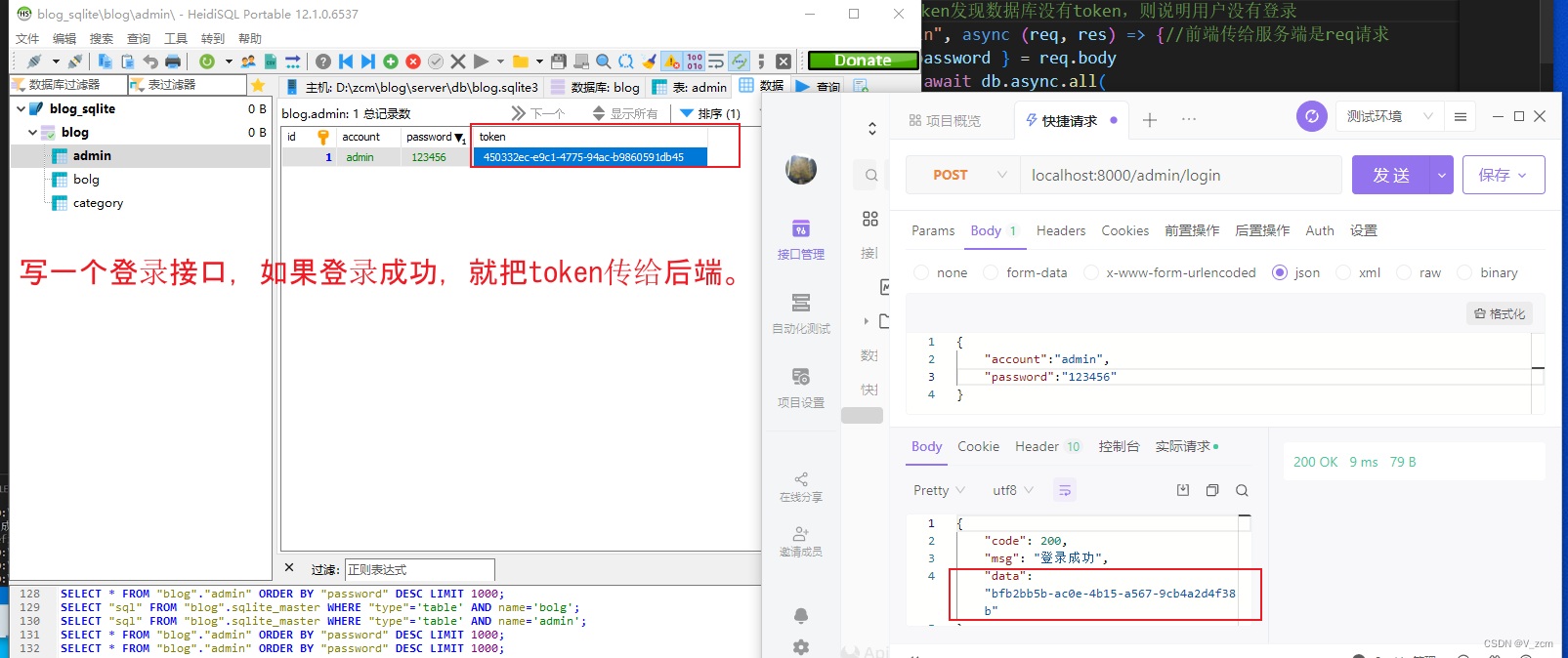
(1)在routers文件夹下面, 创建AdminRouter.js文件,基础搭建(express,路由,数据库,uuid自动生成toke等模块的引入;登录接口;路由暴露出去,这样app.js 才可以引入这个路由中间件)
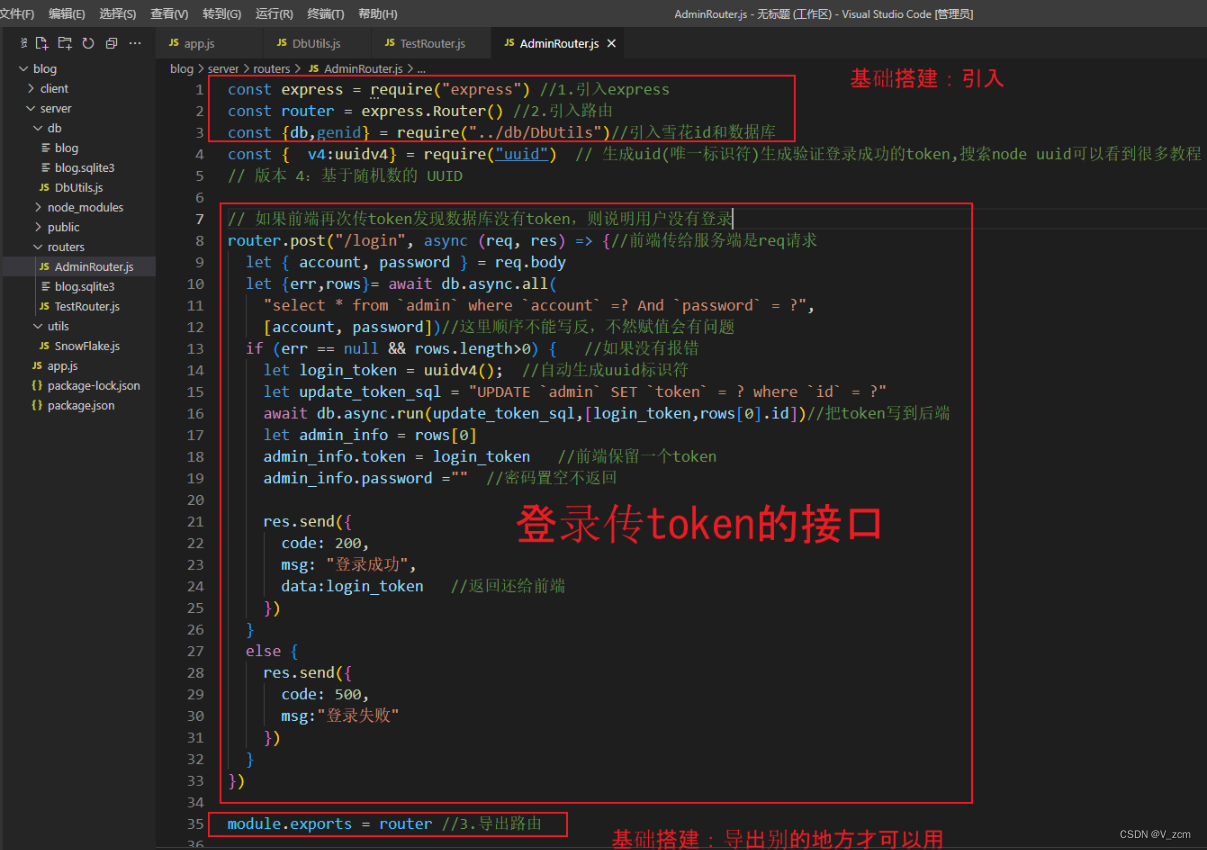
const express = require("express") //1.引入express
const router = express.Router() //2.引入路由
const {db,genid} = require("../db/DbUtils")//引入雪花id和数据库
const { v4:uuidv4} = require("uuid") // 生成uid(唯一标识符)生成验证登录成功的token,搜索node uuid可以看到很多教程
// 版本 4:基于随机数的 UUID
// 如果前端再次传token发现数据库没有token,则说明用户没有登录
router.post("/login", async (req, res) => {//前端传给服务端是req请求
let { account, password } = req.body
let {err,rows}= await db.async.all(
"select * from `admin` where `account` =? And `password` = ?",
[account, password])//这里顺序不能写反,不然赋值会有问题
if (err == null && rows.length>0) { //如果没有报错
let login_token = uuidv4(); //自动生成uuid标识符
let update_token_sql = "UPDATE `admin` SET `token` = ? where `id` = ?"
await db.async.run(update_token_sql,[login_token,rows[0].id])//把token写到后端
let admin_info = rows[0]
admin_info.token = login_token //前端保留一个token
admin_info.password ="" //密码置空不返回
res.send({
code: 200,
msg: "登录成功",
data:login_token //返回还给前端
})
}
else {
res.send({
code: 500,
msg:"登录失败"
})
}
})
module.exports = router //3.导出路由
(2)在app.js文件,引入路由,才可以使用:
app.use("/admin", require("./routers/AdminRouter"))ps:遇到的问题 :1.column index out of range ,这个问题要看前端请求的栏目和后端有的数据栏目是不是不一致。

2. Unexpected token } in JSON at position 119 解决方法:json数据结尾不能有逗号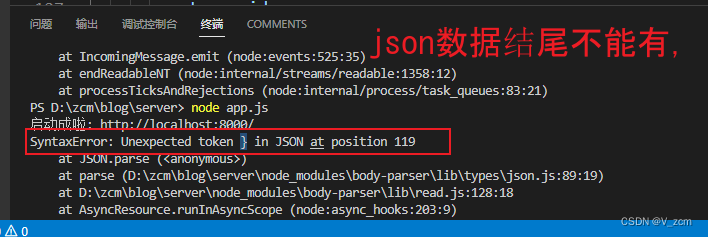
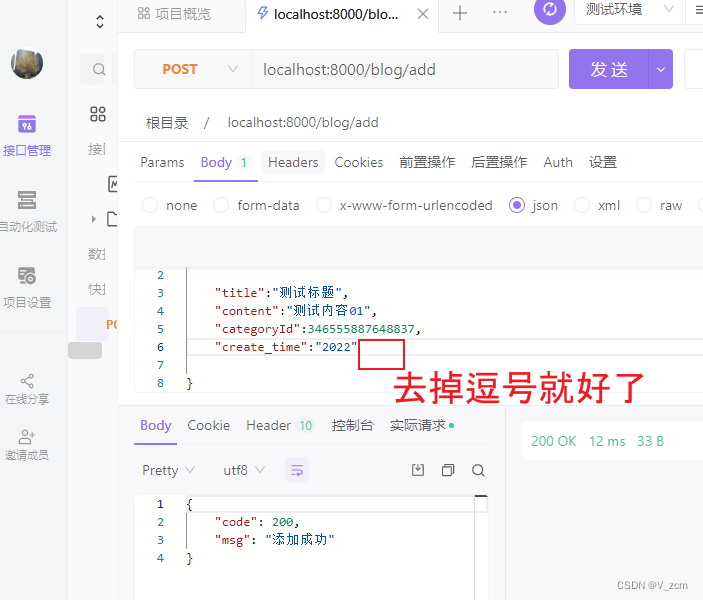
3.数据库表名写错了 4.params赋值的是数组[ ],不是{}
5.await is only valid in async functions and the top level bodies of modules 。
解决方法:async 和await 缺一不可。
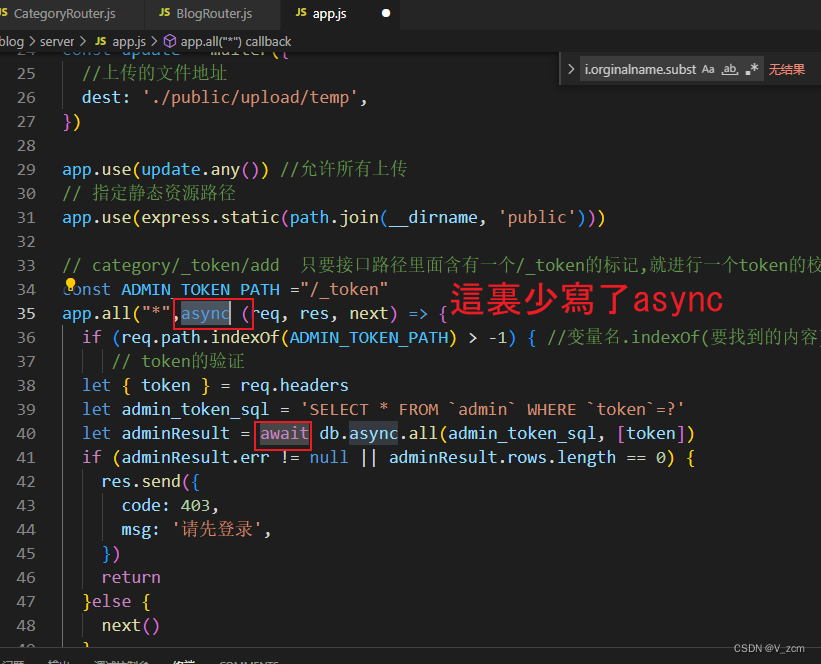
token的验证:
// token的验证
let { token } = req.headers
let admin_token_sql = 'SELECT * FROM `admin` WHERE `token`=?'
let adminResult = await db.async.all(admin_token_sql, [token])
if (adminResult.err != null || adminResult.rows.length == 0) {
res.send({
code: 403,
msg: '请先登录',
})
return
}